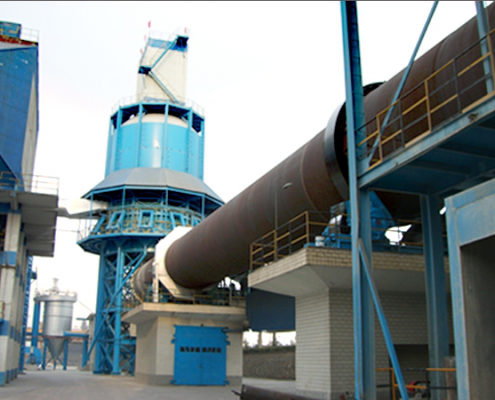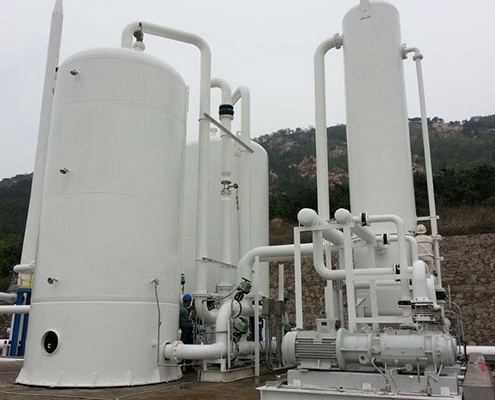Rotary kiln refers to rotary calcination kiln (commonly known as rotary kiln) and belongs to the category of building materials equipment. Rotary kilns can be divided into cement kilns, metallurgical chemical kilns and lime kilns according to different materials processed.
Cement kilns are mainly used for calcining cement clinker, divided into two categories: dry process cement kilns and wet process cement kilns. Metallurgical and chemical kilns are mainly used for magnetizing roasting of iron-poor ore in iron and steel plants in the metallurgical industry; oxidizing roasting of chromium and nickel iron ore; refractory plant roasting high alumina vanadium ore and aluminum plant roasting clinker and aluminum hydroxide; chemical plant roasting chromium ore And chrome ore powder and other minerals.
Lime kiln (ie active lime kiln) is used for roasting active lime and lightly burnt dolomite used in iron and steel plants and ferroalloy plants.
1. Direct heating method: that is, high-temperature gas (which can be direct combustion flue gas or clean air after heat exchange) is input into the kiln, and the gas and materials are fully mixed and contacted for calcination.
2. Indirect heating method: there is a calcination chamber on the outside of the cylinder, the heat generated by the calcination is transferred to the material through the cylinder, and the material is dried, decomposed, calcined and roasted at high temperature. (You can also install a central heating tube to heat the inner and outer cylinder walls of the rotary kiln at the same time, and conduct heat to the materials in the cylinder for calcination)

Rotary kiln calcination installation and commissioning
The installation of rotary kiln involves: lifting and transportation, installation of fitter technology, riveting technology, welding technology, pipeline technology and masonry technology.
1. Construction preparation
In order to ensure the smooth progress of the installation of the cement rotary kiln, the kiln must be inspected and accepted in accordance with the drawings, and the unqualified foundation should be corrected, the debris, chiseling, embedded standards and defense brackets should be removed, and then assembled Longmen hanger, equipment out of storage.
The outgoing warehouse of the rotary kiln equipment must ensure the order of outgoing warehouses and be placed on the construction site reasonably to prevent the installation site from having unfavorable roads or chaotic back and forth transportation. The order of outgoing equipment from the warehouse is: anchor bolts → supporting wheel set → Kiln head cover → Cylinder body, wheel belt, retaining wheel → spring plate, large gear → gear cover → small gear, reducer → engine → auxiliary transmission → smoke chamber and kiln head kiln tail sealing device → burner, cutting device and other attachments.
Check the equipment at the time of leaving the warehouse, clean the equipment according to the relevant requirements, measure the length of simplified Chinese, and then carry out the basic pay-off, lay the horn, the upper surface of the horn should be along the longitudinal direction of the kiln and the slope of the rotary kiln To maintain consistency, the horizontal direction of the kiln must be kept horizontal. In order to accurately and quickly install the equipment at the specified location, there must be an installation reference line no matter the equipment or the specified location. That is, the equipment needs to be scribed, and the center lines of the equipment and equipment must be drawn.

2. Lifting and aligning
The order of hoisting and rectifying is steel base first, then cylinder, first hoist the steel base separately, assemble and perform elevation measurement and rectification on the foundation, when the steel base is adjusted, keep the anchor bolts for grouting and cement mortar pier After the health has reached the strength requirements, then the steel base is corrected for the second time, at the same time, the scraper shaft is scraped, hoisted and paired, and then the supporting roller bearing seat and the supporting roller are found, and the entire tug group is hoisted and aligned. Install the stop wheel.
Lifting and aligning the simplified Chinese, first assemble the cylinder and the wheel, and then align and align the cylinder, and align and align the segments of the cylinder, so that the connection of the center of rotation of each section of the cylinder is on a straight line. Then, connect the large gear ring to the cave body and carry out hoisting and alignment, followed by the positioning and alignment of the transmission device, and then perform the primary bolt grouting alignment and health maintenance, and then perform the secondary alignment of the transmission device.
3. Welding
After the installation and alignment of all the above equipment and the grouting are completed, the kiln body is welded. Generally, manual welding and automatic submerged arc welding are used. After welding, the welding quality is checked, and then the kiln head cover and sealing equipment are installed, followed by cooling and Lubrication system, and then install the coal collision tube, at the same time for the basic secondary grouting, and then carry out no-load debugging and trial operation of the rotary kiln.
4. Masonry refractories
In order to ensure the stiffness and strength of the rotary kiln and make it work normally, after passing the no-load trial operation of the rotary kiln, refractory bricks of different specifications and models are built in the kiln body to protect the rotary kiln from being burned by high temperature during use , Not worn by the material flow.
5. Commissioning
After the installation of the cement rotary kiln equipment is completed, first check whether the technical indicators of the equipment have met the requirements, and the commissioning and trial operation can only be carried out after the relevant departments confirm the qualification. Before commissioning, conduct a comprehensive inspection of the cement rotary kiln and its auxiliary facilities:
(1) Ensure that all fasteners are tightly tightened, and clear all debris inside and outside the kiln, and above and below the foundation, especially between the belt between the gear and the tug;
(2) Check whether there is leakage in each lubricating cold hydraulic system, whether the valve is flexible and reliable, fill oil in place, and the oil pressure, oil temperature and flow rate meet the design requirements;
(3) Check the rotation direction of all instruments, indicators and motors, and comply with the relevant drawings and regulations;
(4) Check the transmission device, there should be no abnormal noise such as impact and vibration, the meshing of the large and small gears should be normal, and the work should be stable;
(5) Check whether the wheel belt and the tug are in normal contact, the contact length is not less than 70%, and the kiln tube body should move up and down smoothly;
(6) Check whether there is any looseness in the devices everywhere, and whether there is friction between the sealing device and the local parts.
If all the technical indexes of the equipment meet the requirements, carry out debugging. When debugging, first debug the main motor. Click the main motor to check and adjust the rotation direction of the main motor so that the relevant parameters of the motor meet the design or regulations .
Start the main motor, run it for 2 hours separately, then drive the main reducer for 4 hours by the main motor, and turn on the cooling and lubrication system, then drive the rotary kiln for 8 hours by the main motor drive transmission system no problem.


